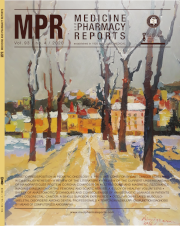Biofilms and inflammation in patients with chronic rhinosinusitis
DOI:
https://doi.org/10.15386/mpr-1691Keywords:
chronic rhinosinusitis, biofilms, eosinophil, plasma cells, microscopyAbstract
Introduction. The aim of the present study is to evaluate the presence of biofilms in patients with chronic rhinosinusitis (CRS), with or without nasal polyps, and their relationship to eosinophils and plasma cells. We compared the results with those obtained in nonCRS patients.
Methods. A total of 50 patients were included in the study, 30 CRSwNP patients, 10 CRSsNP cases and 10 control patients who were operated for deviated septum. Biofilm detection was performed by means of H&E staining and SEM. Eosinophil and plasma cell values were recorded and compared between groups.
Results. Biofilms were identified in 30 patients (60%), 76.6% (23 out of 30) of the CRSwNP patients, 70% (7 out of 10) of the CRSsNP patients and none of the septoplasty patients. Eosinophil and plasma cell values were more elevated in CRS patients, being strongly correlated to biofilm presence and nasal polyposis.
Conclusion. Biofilm presence was demonstrated in many of the CRS patients, with no evidence in the control cases. Our study findings indicate that inflammatory cell counts are higher in patients with CRS compared to controls, but also more elevated in patients with polyposis. In biofilm-positive patients, eosinophil and plasma cell counts were greater than those in patients without biofilms, demonstrating the proinflammatory action of the biofilm in the sino-nasal pathology.
Downloads
Published
How to Cite
Issue
Section
License
The authors are required to transfer the copyright of the published paper to the journal. This is done by agreeing to sign the Copyright Assignment Form. Whenever the case, authors are also required to send permissions to reproduce material (such as illustrations) from the copyright holder.

The papers published in the journal are licensed under a Creative Commons Attribution-NonCommercial-NoDerivatives 4.0 International License.

